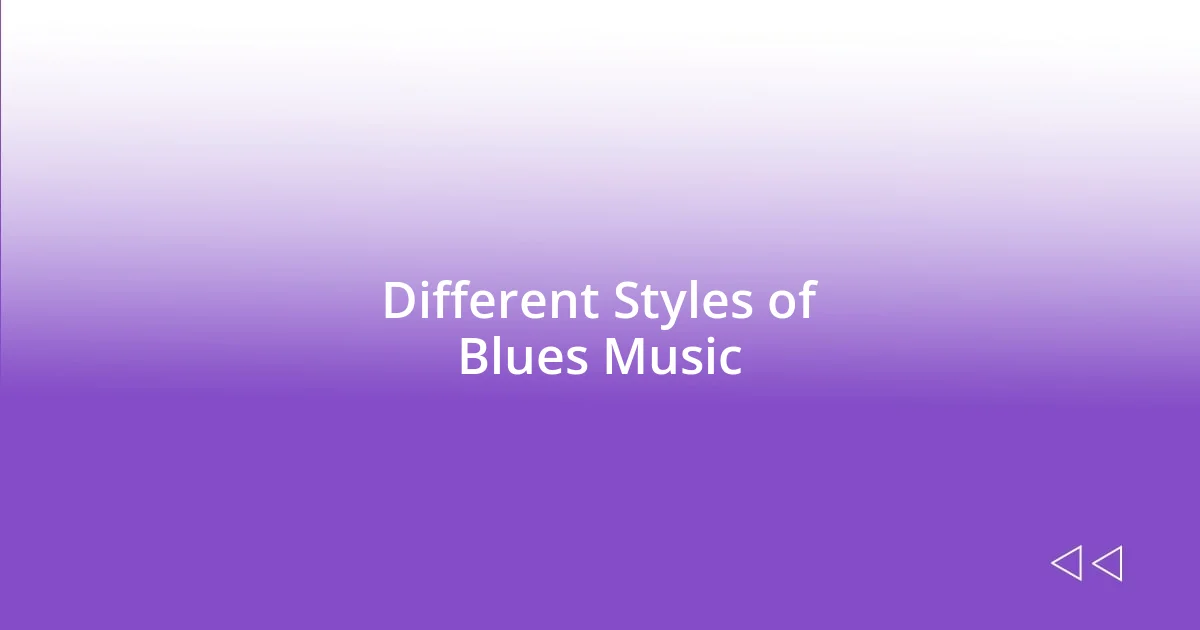Key takeaways:
- The blues genre originated from African American history, highlighting themes of struggle, resilience, and personal storytelling.
- Different styles of blues, including Chicago, Delta, and Texas blues, each contribute unique characteristics and emotional depth to the genre.
- Blues has a profound cultural impact, influencing social change and paving the way for modern music genres, while evolving through contemporary influences and technology.

Understanding the Blues Genre
The blues genre is a captivating amalgamation of emotion, history, and musicality. When I first listened to B.B. King’s “The Thrill Is Gone,” I was struck by how deeply the music resonated with feelings of heartache and longing. It made me wonder—how can mere notes convey such profound sorrow?
At its core, the blues is about storytelling through music. I remember a friend of mine sharing her experience at a local blues jam session, where each musician poured their heart into every lick and lyric. This kind of authenticity is what defines the genre; it’s not just about the sound but about expressing personal narratives that many can relate to.
Interestingly, the roots of the blues trace back to African American history, with origins in work songs and spirituals. This historical context adds layers to the music; it’s a reflection of struggle, resilience, and hope. Have you ever listened to a blues track and felt transported to a different time or place? That’s the power of the blues—it connects us across generations and experiences.

Historical Roots of the Blues
The historical roots of the blues are deeply intertwined with the experiences of African Americans in the South. Originating in the late 19th century, blues music emerged from the harsh realities of life, capturing both pain and resilience. I once attended a lecture on Southern history, and hearing a scholar discuss how these songs birthed from the fields filled me with profound respect for the musicians who transformed their struggles into poetry.
- Blues has its origins in African spirituals, field hollers, and work songs.
- It reflects the social and economic hardships faced by African Americans post-slavery.
- The use of call-and-response patterns in blues rehearse African musical traditions.
- Notable early blues figures, like Robert Johnson and Ma Rainey, helped shape its evolution.
- The genre served as a voice for the marginalized, resonating with themes of joy, sorrow, and perseverance.
Listening to the early recordings takes me back to those moments in the lecture, feeling the weight of history in each note. It’s remarkable to think that every strum and lyric carries a legacy of resistance and hope, speaking volumes about the human experience.

Different Styles of Blues Music
Blues music is incredibly diverse, with a variety of styles that each bring something unique to the table. For instance, Chicago blues is characterized by its electric sound and rhythm, often filled with amplified guitars and harmonicas. I remember the first time I heard Muddy Waters live; the energy in the room was simply electric, making it impossible not to feel every note.
On the other hand, Delta blues takes us back to the roots, featuring acoustic instruments and haunting vocals that convey deep emotion. When I hear a track like “Cross Road Blues” by Robert Johnson, I can’t help but feel transported to a dusty road under a setting sun. The simplicity of Delta blues allows for such raw vulnerability, making those heartfelt stories hit even harder.
There’s also Texas blues, known for its swing and improvisational flair, which adds a different flavor to the genre. After discovering Stevie Ray Vaughan, I found myself captivated by his virtuosic guitar work and passionate vocals. It was a revelation—showing me just how expansive the blues can be. Each style not only enriches the genre but also tells a story in its own right.
| Style | Characteristics |
|---|---|
| Chicago Blues | Electric sound, often features amplified guitars and harmonicas, high energy. |
| Delta Blues | Acoustic focus, deep emotion, haunting vocals, often tells poignant stories. |
| Texas Blues | Known for swing, improvisation, and virtuosic guitar work, adds a lively flair. |

Influential Blues Artists to Explore
One artist I deeply appreciate is B.B. King. His guitar solos always carry a sense of storytelling that feels like an intimate conversation. Listening to him play “The Thrill is Gone” for the first time, I was struck by the way each note conveyed his longing and vulnerability. It truly made me wonder—how does he manage to express such raw emotion through his instrument alone?
Another influential figure is Etta James. Her powerful voice not only captures the essence of blues but also transcends it. I had the chance to attend a tribute concert featuring her legendary hits, and I was astonished by how each song felt like a personal reflection of joy and heartbreak. It’s moments like these that make me question how one person can evoke such a spectrum of emotions through music.
Finally, I can’t overlook the impact of Howlin’ Wolf. His growling vocal style and commanding presence were unlike anything I had experienced before. The first time I listened to “Smokestack Lightning,” it was as if he transported me to a smoky juke joint filled with stories yet untold. How did he manage to embody the very soul of the blues? It’s a testament to the powerful connection he forged with his audience, reminding us why the blues continues to resonate so deeply.

Cultural Impact of the Blues
The cultural impact of the blues is vast and multifaceted, reaching far beyond its musical origins. I remember sitting in a small café, where the local band played a soulful rendition of “Amazing Grace” infused with blues undertones. It struck me how this genre can reshape even the most sacred songs into something deeply relatable and human. How powerful it is that the blues transcends cultural and generational boundaries!
Blues music has also been a profound catalyst for social change. Take the civil rights movement—songs like “We Shall Overcome,” although rooted in a gospel tradition, carried a bluesy weight that fueled hope and resilience. When I think back to artists like Nina Simone, her ability to convey heartbreak and defiance through blues-infused tracks still resonates with those who seek justice and equality. Isn’t it fascinating how music can inspire collective action and give voice to the voiceless?
Moreover, the blues has paved the way for countless genres, from rock and roll to hip-hop, shaping the soundscapes we enjoy today. I vividly recall a late-night jam session with friends, where we blended blues riffs with modern beats. It led me to realize that this timeless genre not only influences musicians but also invites them to innovate and experiment. So, in many ways, isn’t the blues not just a genre but a continuous dialogue with our lives and culture?

Blues Today and Its Evolution
Blues today is a vibrant tapestry woven from its rich history and ever-changing influences. I recently attended a local blues festival that showcased a diverse range of artists, from traditional legends to contemporary singers who infuse blues with elements of pop and rock. It made me ponder: how does the soul of the blues evolve while still honoring its roots?
Listening to a young artist blend trap rhythms with classic 12-bar blues was a revelation. Their unique spin felt like a bridge connecting generations—an acknowledgment that while the sound may shift, the raw emotions of love, pain, and resilience remain constant. I couldn’t help but smile as I witnessed older fans both nodding in appreciation and younger audiences dancing with zest. Doesn’t it signify that blues is not just a genre but a living, breathing entity?
Today’s blues artists are also using technology to reach a broader audience. Platforms like YouTube and Spotify allow them to share their stories and sounds globally. I’ve found that some of my favorite blues tracks can be discovered with just a few clicks, and this accessibility ignites my curiosity: how will the next generation of blues musicians shape the genre? As they continue to experiment and innovate, I believe the blues will not only endure but flourish, reflecting the complexities of our modern lives.

How to Appreciate Blues Music
To truly appreciate blues music, immerse yourself in its stories and emotions. I recall a quiet evening spent listening to a classic Muddy Waters album, each note resonating with a deep sense of longing and heartache. It hit me then that the blues is not just music; it’s a window into the soul’s struggles and triumphs. Have you ever felt an overwhelming connection to a song? That’s the magic of blues—it speaks to the shared human experience.
Engaging with blues goes beyond passive listening; it’s about feeling the rhythm in your bones. I often find myself tapping my foot to a slow, steady beat, allowing the music to guide my emotions. The way a skilled guitarist bends a note can evoke tears or laughter in an instant. Have you ever felt that surge of energy when a perfect riff strikes? Those moments can transport you, revealing the genre’s raw power and authenticity.
Attending live blues performances can deepen your appreciation immensely. I remember my first blues concert—it was held in an intimate venue, where the closeness of the audience made every guitar strum feel personal. As the crowd swayed together, I realized that blues is as much about community as it is about individual expression. Don’t you think that experiencing music with others enhances its impact? It’s in these shared moments that the spirit of blues truly comes alive.












